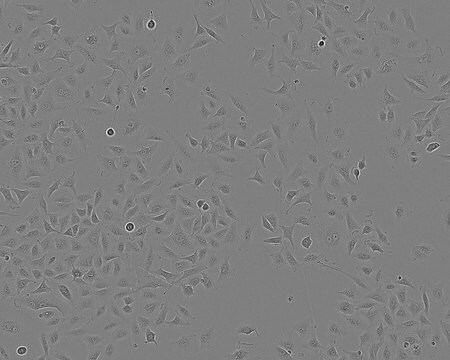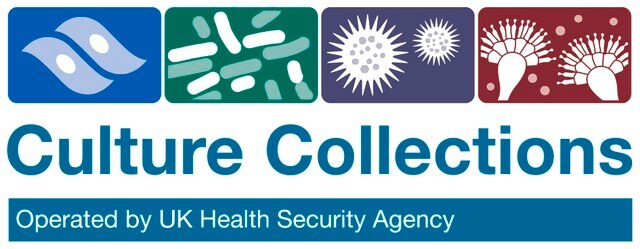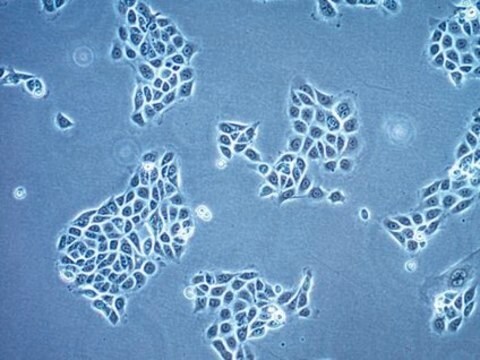NCI-H292
91091815, human lung, Epithelial
Synonim(y):
Komórki H292, Komórki NCI-HUT-292
Zaloguj sięWyświetlanie cen organizacyjnych i kontraktowych
About This Item
Kod UNSPSC:
41106514
Polecane produkty
Nazwa produktu
NCI-H292, 91091815
pochodzenie biologiczne
human lung
tryb wzrostu
Adherent
kariotyp
Modal no. 47
morfologia
Epithelial
produkty
Not specified
receptory
Not specified
metody
cell culture | mammalian: suitable
powiązane choroby
metastasis
Warunki transportu
dry ice
temp. przechowywania
−196°C
Pochodzenie linii komórkowej
Ludzkie płuca, rak śluzowo-naskórkowy
Opis linii komórkowej
Pochodzi z przerzutu do węzła szyjnego raka śluzowo-naskórkowego płuc u 32-letniej kobiety. Komórki zachowują cechy śluzowo-naskórkowe w hodowli i wspierają replikację wirusa zapalenia wątroby typu B. Niektóre komórki zawierają liczne małe granulki zawierające mucynę i są ujemne pod względem dekarboksylazy L-DOPA. Ta linia komórkowa została wybrana jako prototyp do transfekcji fragmentów subgenomu do ludzkich komórek w celu zbadania roli HBV i jego poszczególnych genów w patogenezie wirusowego zapalenia wątroby i raka wątroby. Komórki są mukokarminododatnie, a także pozytywnie wybarwiają się na keratynę i wimentynę, ale negatywnie na białko tripletowe neurofilamentu. Pochodzenie etniczne: Czarny.
Zastosowanie
Linia komórkowa NCI-H292 została wykorzystana do określenia zdolności linii komórkowej do wspierania replikacji wirusa świnki.
Profil DNA
Dane STR-PCR: Amelogenina: X
CSF1PO: 10
D13S317: 11,12
D16S539: 9,13
D5S818: 13
D7S820: 10
THO1: 8
TPOX: 8,11
vWA: 16,17
CSF1PO: 10
D13S317: 11,12
D16S539: 9,13
D5S818: 13
D7S820: 10
THO1: 8
TPOX: 8,11
vWA: 16,17
pożywka hodowlana
RPMI 1640 + 2mM Glutamine + 10% Foetal Bovine Serum (FBS).
Rutyna subkultury
Rozdzielić subkonfluentne hodowle (70-80%) w stosunku 1:3 do 1:10, tj. wysiać 1-3x10 000 komórek/cm2 przy użyciu 0,25% trypsyny lub trypsyny/EDTA; 5%CO2; 37°C.
Inne uwagi
W przypadku przesyłek w regionie Azji i Pacyfiku mogą obowiązywać dodatkowe opłaty za transport i obsługę. Więcej informacji można uzyskać u lokalnego przedstawiciela działu obsługi klienta.
Ta strona może zawierać tekst przetłumaczony maszynowo.
Wybierz jedną z najnowszych wersji:
Certyfikaty analizy (CoA)
Lot/Batch Number
It looks like we've run into a problem, but you can still download Certificates of Analysis from our Dokumenty section.
Proszę o kontakt, jeśli potrzebna jest pomoc Obsługa Klienta
Masz już ten produkt?
Dokumenty związane z niedawno zakupionymi produktami zostały zamieszczone w Bibliotece dokumentów.
Nasz zespół naukowców ma doświadczenie we wszystkich obszarach badań, w tym w naukach przyrodniczych, materiałoznawstwie, syntezie chemicznej, chromatografii, analityce i wielu innych dziedzinach.
Skontaktuj się z zespołem ds. pomocy technicznej


